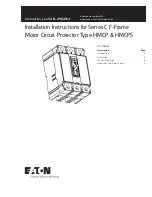
6 F 2 T 0 1 7 2
4.2.6 Changing the Settings
The "Set. (change)" sub-menu is used to make or change settings for the following items:
Password
Description
Relay address and IP address
Baud rate in IEC60870-103 or Modbus
IEC 61850 setting
Recording setting
Status setting
Protection setting
Binary input setting
Binary output setting
LED setting
Control setting
Frequency setting
All of the above settings except the password can be seen using the "Set. (view)" sub-menu.
CAUTION
Modification of settings :
Care should be taken when modifying settings for "active group",
"scheme switch" and "protection element" in the "Protection" menu. Dependencies exist between
the settings in the various menus, with settings in one menu becoming active (or inactive) depending
on the selection made in another menu. Therefore, it is recommended that all necessary settings
changes be made while the circuit breaker tripping circuit is disconnected.
Alternatively, if it is necessary to make settings changes with the tripping circuit active, then it is
recommended to enter the new settings into a different settings group, and then change the "active
group" setting, thus ensuring that all new settings become valid simultaneously.
4.2.6.1 Setting Method
There are three setting methods as follows:
- To enter a selected item
- To enter a text string
- To enter numerical values
To enter a selected item
If a screen as shown below is displayed, perform setting as follows.
The cursor can be moved to upper or lower lines within the screen by pressing the
▲
and
▼
keys.
If setting (change) is not required, skip the line with the
▲
and
▼
keys.
101
Summary of Contents for GRE110
Page 183: ...6 F 2 T 0 1 7 2 Appendix B Signal List 184 ...
Page 191: ...6 F 2 T 0 1 7 2 Appendix C Event Record Items 192 ...
Page 196: ...6 F 2 T 0 1 7 2 Appendix D Binary Output Default Setting List 197 ...
Page 199: ...6 F 2 T 0 1 7 2 Appendix E Relay Menu Tree 200 ...
Page 210: ...6 F 2 T 0 1 7 2 Appendix F Case Outline 211 ...
Page 211: ...6 F 2 T 0 1 7 2 Case Outline for model 400 401 420 421 820 and 821 212 ...
Page 212: ...6 F 2 T 0 1 7 2 Case Outline for model 402 and 422 213 ...
Page 213: ...6 F 2 T 0 1 7 2 Appendix G Typical External Connection 214 ...
Page 245: ...6 F 2 T 0 1 7 2 Appendix J Return Repair Form 246 ...
Page 249: ...6 F 2 T 0 1 7 2 Customer Name Company Name Address Telephone No Facsimile No Signature 250 ...
Page 250: ...6 F 2 T 0 1 7 2 Appendix K Technical Data 251 ...
Page 256: ...6 F 2 T 0 1 7 2 Appendix L Symbols Used in Scheme Logic 257 ...
Page 259: ...6 F 2 T 0 1 7 2 Appendix M Modbus Interoperability 260 ...
Page 289: ...6 F 2 T 0 1 7 2 Appendix N IEC60870 5 103 Interoperability 290 ...
Page 296: ...6 F 2 T 0 1 7 2 Appendix O PLC Default setting 297 ...
Page 298: ...6 F 2 T 0 1 7 2 Appendix P Inverse Time Characteristics 299 ...
Page 304: ...6 F 2 T 0 1 7 2 Appendix Q IEC61850 Interoperability 305 ...










































